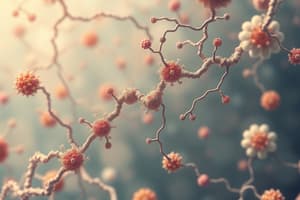Podcast
Questions and Answers
What effect does denaturation have on proteins?
What effect does denaturation have on proteins?
- It enhances their function.
- It converts them into nucleic acids.
- It stabilizes their three-dimensional shape.
- It causes loss of structure and function. (correct)
Which statement about DNA and RNA is true?
Which statement about DNA and RNA is true?
- RNA can fold into diverse shapes. (correct)
- DNA replication does not involve copying.
- Both DNA and RNA are double-stranded.
- DNA contains uracil instead of thymine.
What are receptors in cell signaling?
What are receptors in cell signaling?
- Non-protein-based catalysts involved in signaling.
- Proteins that bind signaling molecules. (correct)
- Lipids that regulate gene expression.
- Molecules that inhibit signal transmission.
Which of the following correctly describes Gibbs free energy?
Which of the following correctly describes Gibbs free energy?
What is the primary role of second messengers in signaling pathways?
What is the primary role of second messengers in signaling pathways?
Which biomolecule is primarily responsible for providing energy and structural support?
Which biomolecule is primarily responsible for providing energy and structural support?
What is the primary function of enzymes in biochemical reactions?
What is the primary function of enzymes in biochemical reactions?
Which statement about the structure of DNA is correct?
Which statement about the structure of DNA is correct?
What defines the tertiary structure of a protein?
What defines the tertiary structure of a protein?
Which metabolic process is characterized by the breakdown of complex molecules to release energy?
Which metabolic process is characterized by the breakdown of complex molecules to release energy?
What occurs during oxidative phosphorylation in cellular respiration?
What occurs during oxidative phosphorylation in cellular respiration?
Which of the following best describes a disaccharide?
Which of the following best describes a disaccharide?
Competitive inhibition of an enzyme occurs when:
Competitive inhibition of an enzyme occurs when:
Flashcards
Protein Folding
Protein Folding
The process by which a linear chain of amino acids folds into a three-dimensional structure, essential for its function.
Protein Denaturation
Protein Denaturation
The loss of a protein's three-dimensional structure, causing it to become inactive and potentially harmful.
DNA Structure
DNA Structure
A double-stranded helix composed of nucleotides, carrying genetic information.
RNA Structure
RNA Structure
Signup and view all the flashcards
DNA Replication
DNA Replication
Signup and view all the flashcards
What is biochemistry?
What is biochemistry?
Signup and view all the flashcards
What are biomolecules?
What are biomolecules?
Signup and view all the flashcards
What are proteins?
What are proteins?
Signup and view all the flashcards
What is catabolism?
What is catabolism?
Signup and view all the flashcards
What is anabolism?
What is anabolism?
Signup and view all the flashcards
What are enzymes?
What are enzymes?
Signup and view all the flashcards
What is the primary structure of a protein?
What is the primary structure of a protein?
Signup and view all the flashcards
What is the tertiary structure of a protein?
What is the tertiary structure of a protein?
Signup and view all the flashcards
Study Notes
Biochemistry Basics
- Biochemistry is the study of chemical processes within and relating to living organisms.
- It focuses on the structure, function, and interactions of biomolecules like proteins, carbohydrates, lipids, and nucleic acids.
- Central to biochemistry is the understanding of metabolic pathways, which are series of enzyme-catalyzed reactions that build and break down molecules.
Biomolecules
- Proteins: Composed of amino acids; crucial for structural support, catalysis (enzymes), transport, and signaling.
- Amino acid structure: Contains an amino group, carboxyl group, side chain (R group).
- Protein structure: Primary, secondary (alpha-helices, beta-sheets), tertiary, quaternary.
- Carbohydrates: Provide energy and structural support.
- Simple sugars (monosaccharides): e.g., glucose, fructose.
- Disaccharides: e.g., sucrose, lactose.
- Polysaccharides: e.g., starch, glycogen, cellulose.
- Lipids: Diverse group of hydrophobic molecules, including fats, phospholipids, and steroids.
- Fats: Energy storage, insulation.
- Phospholipids: Major components of cell membranes.
- Steroids: e.g., cholesterol, hormones.
- Nucleic acids: DNA and RNA; carry genetic information.
- DNA: Double helix structure, carries genetic code.
- RNA: Single-stranded, crucial in protein synthesis.
Metabolism
- Catabolism: Breakdown of complex molecules into simpler ones, releasing energy.
- Anabolism: Building of complex molecules from simpler ones, requiring energy.
- Cellular respiration: Key catabolic pathway, using glucose to produce ATP (energy currency).
- Glycolysis: Initial step in respiration, breaking down glucose.
- Krebs cycle (Citric Acid Cycle): Further breakdown of intermediates.
- Oxidative phosphorylation: Major ATP production via electron transport chain.
- Photosynthesis: Anabolic process, converting light energy into chemical energy (glucose).
Enzymes
- Biological catalysts, speeding up reactions without being consumed.
- Active site: Region where the substrate binds.
- Factors affecting enzyme activity: Temperature, pH, substrate concentration.
- Enzyme specificity: Enzymes typically bind to specific substrates.
- Enzyme inhibition: Competitive and non-competitive inhibition.
Protein Structure and Function
- Primary structure: Sequence of amino acids.
- Secondary structure: Alpha-helices and beta-sheets.
- Tertiary structure: Three-dimensional folding of the polypeptide chain.
- Quaternary structure: Multiple polypeptide chains interacting.
- Protein folding: Crucial for function.
- Protein denaturation: Loss of structure and function due to external factors (heat, pH).
Nucleic Acids Structure
- DNA structure: Double helix with base pairing (A-T, G-C).
- RNA structure: Single-stranded, can fold into diverse shapes.
- DNA replication: Copying of DNA.
- Transcription: Synthesis of RNA from DNA.
- Translation: Synthesis of proteins from mRNA.
- Gene expression: Regulation of gene activity.
Cell Signaling
- Communication between cells and within cells.
- Signaling pathways: Networks of proteins involved in transmitting signals.
- Receptors: Proteins that bind signaling molecules.
- Second messengers: Molecules involved in relaying signals within the cell.
Key Concepts
- Thermodynamics: Energy transformations in biological systems.
- Laws of thermodynamics: Energy conservation and entropy increase.
- Gibbs free energy: Measures spontaneity of reactions.
Studying That Suits You
Use AI to generate personalized quizzes and flashcards to suit your learning preferences.




